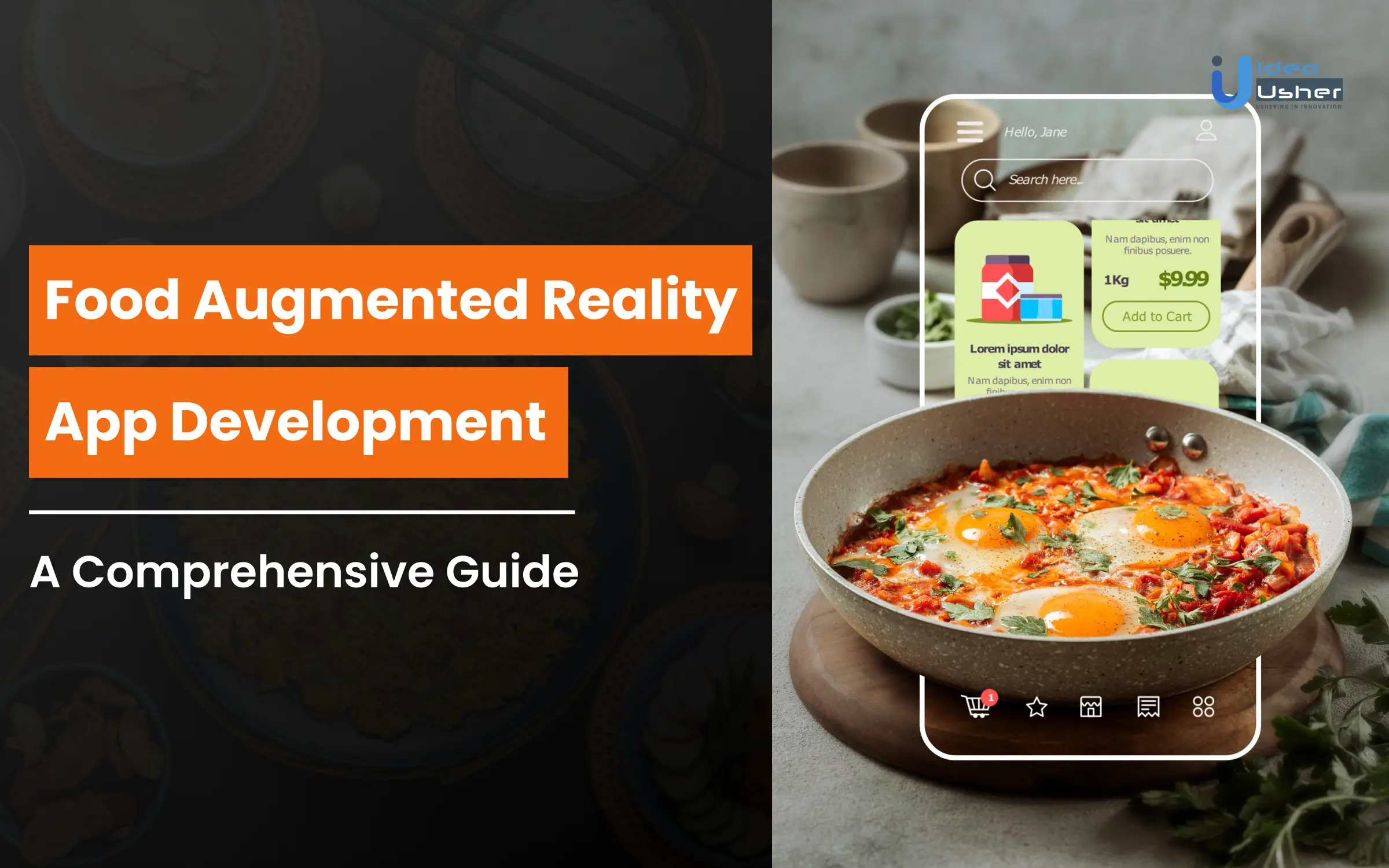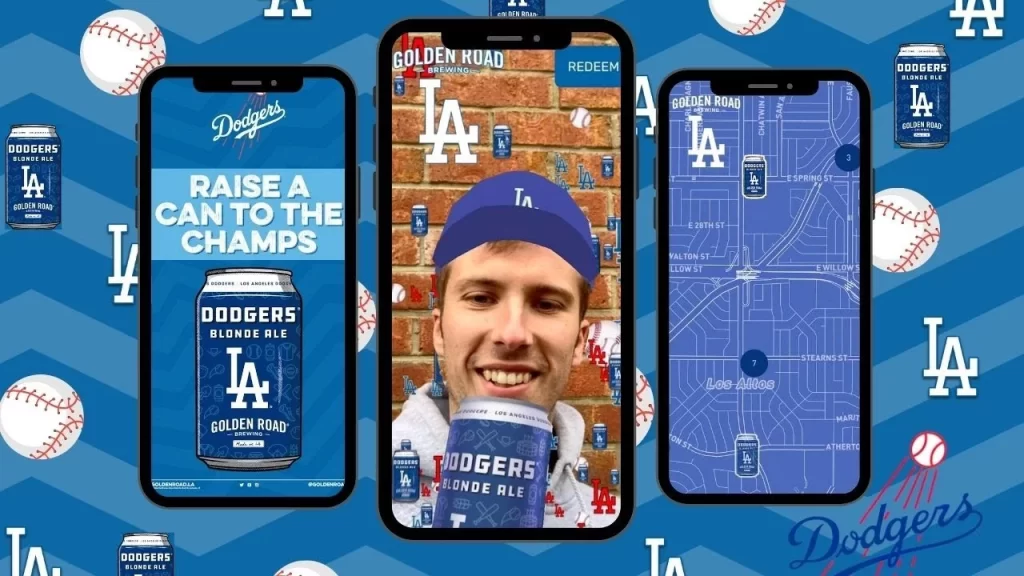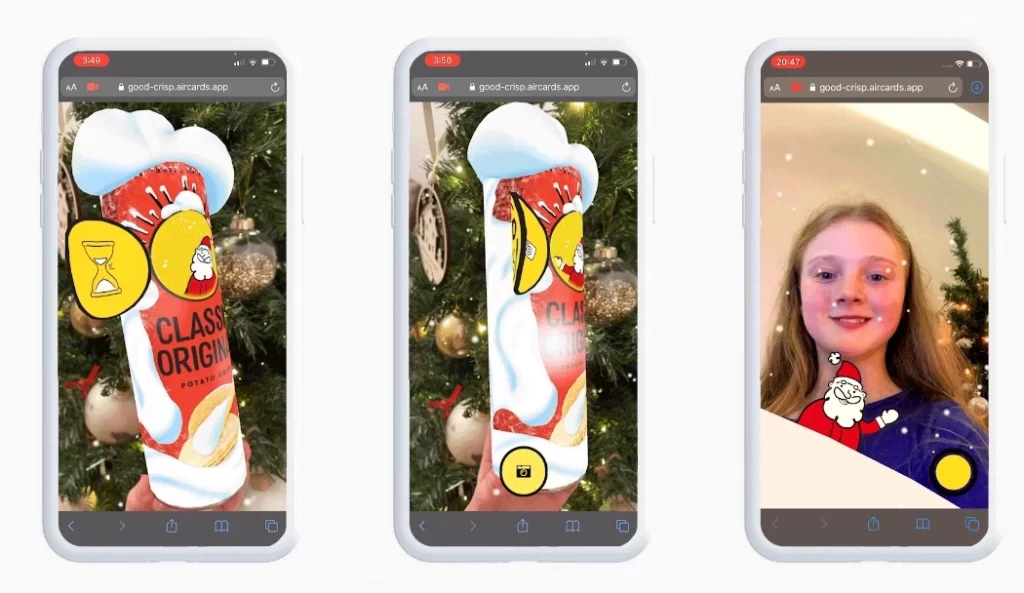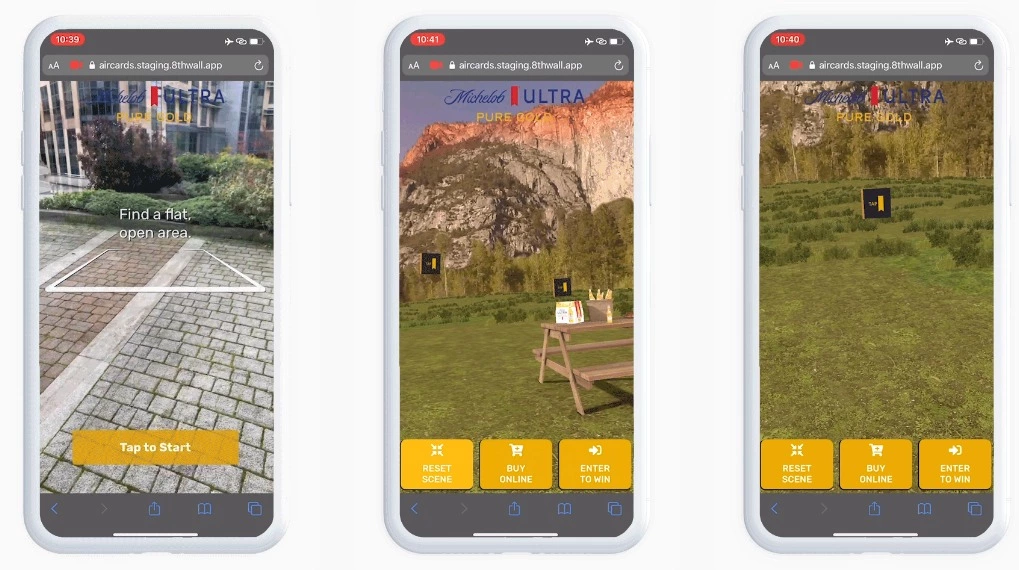
AR technology has gradually expanded its applications and use cases beyond gaming and other industries. Nowadays, the food and beverage industry is also utilizing augmented reality to drive customer engagement and innovation in their business.
The development of food-centric augmented reality apps opens up endless opportunities.
With AR, restaurants can craft virtual dining environments that transport users to distant lands and empower them with real-time information about ingredients and nutritional values.
Let’s explore the entire journey of food augmented reality app development with use cases, development steps, and required technological stack.
What Is AR In The Food Industry?
Augmented Reality in the food industry refers to digital technology that overlays virtual elements in the real world, which drives user engagement with food-related content, products, and experiences.
AR technology bridges the gap between the digital and physical worlds, allowing users to interact with computer-generated information, visuals, and animations. The users can access AR technology through their devices, such as smartphones, AR glasses, and tablets.
The use of AR technology in the food industry enables users to interact with and appreciate food by bringing digital innovation to the heart of the cooking and dining experience.
Use Cases Of AR In The Food Industry
AR is bringing enormous opportunities for the food industry to scale its business by driving user engagement, virtualization, etc.
Here are some of the widespread use cases of AR in the food industry
1. Enhanced Information
Customers can access the restaurant menu and get a realistic view of each dish. Moreover, customers can scan the restaurant menu by using their smartphones and can access additional details such as nutritional information and ingredients from each restaurant dish.
2. Upsell
Restaurants can access an enhanced way for upselling opportunities by offering a pairing suggestion to their customers, such as appetizers, recommended drinks or desserts, by creating an engaging dish menu with augmented reality.
3. Promotions
With the help of augmented reality, restaurants can run promotions regarding their special events, discounts, and seasonal food offerings and can drive more engagement to their business.
4. Improve Customer Engagement
Restaurants can access augmented reality to create a unique opportunity to represent cooking, demonstration, chef interviews, and testimonials to drive more customer engagement to their business.
5. Customer Satisfaction
Restaurants can gain valuable insights by offering an interactive food menu powered by augmented reality. The digital restaurant menu will help restaurants identify which items are ordered the most. The following valuable insights will help restaurants to improve the customer experience by offering them customized restaurant experiences.
6. Food Manufacturing Optimization
Maintaining refrigeration temperature, allergen control, and equipment sanitization are the few challenging areas where AR can help restaurants manage them smartly by offering them virtual and detailed insights.
7. Training Tool
Employee training is an essential aspect for almost all restaurants to speed up their business operations and minimize risk across the operational chain.
Restaurants can access a wide range of virtual training programs powered by augmented reality, where they can provide and enhance staff training.
8. Boosts Employee Safety
There are various kinds of hazardous risks associated with restaurant businesses.
Using AR, restaurants can provide training and in-depth information instruction to ensure employees perform each step properly while maintaining different kinds of restaurant business operations.
9. Viral Marketing Campaigns
Boosting marketing campaigns and enhancing customer experience and engagement by leveraging the power of marketing campaigns is a way for restaurants to stand out from the competition.
Many restaurant brands are using the innovative technology of augmented reality to scale up their business with different marketing campaigns.
Take Burger King, for example, which used AR technology to launch a “Burn the Ad” campaign.
In this campaign, patrons can use the Burger King app to burn a competitor’s ads virtually. After burning the ad, the app presented the user with a coupon for a discount at a Burger King store.
10. Boosts Customer Safety
Augmented Reality (AR) in the food and beverage industry enhances safety by providing real-time information about ingredients, allergens, and nutritional data. Customers can scan products or menus to make informed choices, reducing the risk of allergies or dietary concerns.
11. Packaging Goes Live!
AR breathes life into packaging by enabling interactive elements. Customers can scan QR codes to access recipes, cooking instructions, or origin stories of the product. This engages consumers and fosters a stronger connection between the brand and its customers.
12. Improves the Dining Experience
AR enhances the dining experience by offering virtual menus with 3D food visualizations, ingredient information, and even the ability to visualize how a dish is prepared. This technology elevates restaurant visits, making them more engaging and informative for patrons.
How To Implement Augmented Reality In Food Industry Business?
Implementing augmented reality in the food industry requires several steps to create an engaging and interactive experience for their customers.
Here is a more detailed guide on implementing augmented reality in the food industry.
1. Define Objectives and Use Cases
Determine the use cases where AR can be added to enhance the value of your restaurant businesses, such as creating virtual menus, gamified promotions, interactive cooking instructions, etc.
There are many use cases that the food industry business can use to bring value to their business, such as creating interactive food menus, educating staff about ingredients and cooking methods, gamified marketing campaigns, virtual food testing, etc.
2. Set Clear Objectives
It will be best to identify specific goals you want to achieve by implementing AR in your food business, such as improving brand awareness, enhancing customer engagement, or increasing sales.
You can explore popular examples where different businesses in the food industry are leveraging the power of AR to bring enormous value to their customers with different virtual experiences.
3. Choose the AR Platform
The selection of an appropriate AR development platform for creating and implementing digital solutions for the food business is crucial.
There are various AR development tools and platforms available that developers can use, such as ARCore for Android, AR Kit for iOS, and web-based AR solutions.
It would be best to consult with an augmented development company that will identify your project goals and requirements and help you select the best AR development platform for your business.
4. Develop AR Content
Creating AR content will enable you to enhance the overall customer experience. High-quality AR content will help you to align with your brand identity and business use cases, such as showcasing the virtual version of food items, menus, restaurant interiors, etc.
The development of AR content includes 3D models of dishes, videos, animations, and interactive elements like hotspots or buttons.
5. AR App Development
The development phase of the AR app can be categorized into two parts: front and back-end development.
I. Front-end development
Create a user-friendly interface that will allow users to access AR content in addition to their interactive elements, such as hotspots, buttons, and animations, for overall enhancing user engagement.
Moreover, try to develop a user-friendly interface that will be initiative and guide users for facilitating a smooth flow throughout the platform.
II. Back-end development
The back-end development part will require real-time data integration with back-end systems such as API implementation, developing backend functionality and features, etc.
6. Testing and Debugging
It is crucial to offer an enhanced AR experience where the platform is free from all technical glitches and bugs.
The best way to offer a bug-free experience is to identify and address different kinds of possible glitches, bugs, or performance issues that may arise during testing and fix them.
7. Performance Optimization
Consider various optimization factors such as memory usage, battery optimization, and other crucial aspects.
Optimizing the different performance optimization, such as minimizing loading times and ensuring smooth animations and interactions, will help you offer an enhanced platform experience to your customers.
8. User Education and Support
Provide clear instructions and tutorials for your users to guide them about accessing AR-related services and features.
You can include many support channels for users with questions or issues accessing your Augmented Reality-based food application.
9. Deployment
Publish the AR app on the relevant app stores (e.g., Apple App Store, Google Play Store) or deploy it on your website. Add images and videos to app stores that resonate with your food brand identity to help you with business scaling.
10. Promotion and Marketing
Develop a marketing strategy to promote your AR app to your target audience and utilize social media, email campaigns, and other channels to create awareness.
It would be best if the AR development firm also comprises a marketing team that can help you with scaling and expanding the reach of your AR-based food platform.
11. Data Analytics and Iteration
Integrate various analytics tools to identify and track user engagement and behavior within the app, such as most ordered dishes, data collection from successful marketing campaigns, etc. Moreover, try to analyze the data to identify areas of improvement and enhance the AR experience based on user feedback.
12. Legal and Privacy Compliance
Clearly communicate your data usage and privacy policies to users, as it would help you ensure that your AR platform complies with relevant privacy and data protection laws.
13. Continuous Updates and Innovation
Keep your AR-based food app updated with new features and content to drive engagement and more users to your platform. Consider adding new content regularly regarding virtual cooking classes, interactive recipe showcases, and seasonal and trendy recipes to your app.
Top 5 Examples Of Augmented Reality In The Food Industry
Explore the app examples showcasing the best use of AR technology in the food industry.
1. Kinder “Jump Into Africa”

The platform provides a walk-through of a virtual world that customers can explore by scanning an invitation-based QR code.
By clicking on “Tap to Start”, an animated doorway pops up and opens a portal where users can interact with 3D animated animals where users can read infographics of each character.
2. Golden Road Brewing

A Los Angeles-based newspaper agency has started a Brewing ad campaign named “Raise a Can with the Champs.” where users enter the Web AR, and the camera shows the user wearing a CGI Dodgers by switching to a selfie mode.
The users can capture this moment and can share them on social media and can tap on the link to a rebate for the product.
3. Stillhouse Whiskey

The platform provides a highly engaging connected packaging experience that transforms a Stillhouse whiskey can into an immersive consumer journey.
Stillhouse Whiskey AR platform features a fully functional map with custom 3D animation that lists thousands of points of interest across the United States, including some amazing Federal Nature Reserve walks with every store location stocking Stillhouse in the USA.
4. The Good Crisp Company

The chip can instantly transform into a virtual Christmas miracle, with snow falling atop it and Santa appearing from beneath the logo, waving at the customer. As the user moves the canister in their hand, the animation moves along, immersing the customer in the magic.
The company instantly transforms the chip into a virtual Christmas animation in addition to the snow falling atop it where Santa waves at the customer. The animation moves along with the canister when users move it along with their hand, which offers them an immersive experience. Moreover, users can take selfies with a cartoon Santa and share their pictures on social media.
5. Michelob Ultra’s Portal to Yosemite

Another AR-based food app example, where users can enter a virtual world with an invitation to “Tap to enter Yosemite”.
The virtual world offers majestic views and a picnic table featuring Michelob products. The platform provides easy instruction where users can walk into a virtual Yosemite National Park.
Tech Stack For AR Development In The Food Industry
Developing an augmented reality (AR) application for the food industry requires a combination of software and hardware technologies to create an immersive and engaging user experience. Here’s a suggested tech stack for food augmented reality development:
1. 3D Modeling and Animation
Blender / Maya: Used to create realistic 3D food models that users can interact with in the AR environment.
2. Programming Languages
Unity (C#): A popular game development engine that provides a user-friendly interface and supports cross-platform development.
3. AR Platforms and SDKs
- ARKit (iOS) / ARCore (Android): Native development kits for iOS and Android platforms
- Vuforia: A cross-platform AR development kit that supports marker-based and markerless tracking, making it suitable for various AR experiences
4. Cloud Services
Amazon Web Services (AWS) / Microsoft Azure: Used for hosting AR content, managing user data, and integrating features like object recognition or complex computations.
5. Backend Development
Node.js / Django / Flask: Depending on your preferences and expertise, you can choose a backend framework to handle data processing, user authentication, and API interactions.
6. Computer Vision
OpenCV: OpenCV is an open-source computer vision library that can be used to enhance AR experiences by implementing features like image recognition and tracking.
7. Frontend Development
React Native / Flutter: If you’re building a mobile app with AR features, frameworks like React Native or Flutter can help you create a seamless user interface.
8. Database
Firebase / MongoDB: Choose a database solution for storing user data, app content, and interactions.
9. Testing and Quality Assurance
Automated Testing Tools: Use testing frameworks like Jest, XCTest, or Espresso to test your app’s functionality.
10. User Testing Platforms
UserTesting or PlaybookUX: For gathering valuable feedback from users.
11. Deployment
App Stores: Apple App Store and Google Play Store for distributing your app among mobile devices.
12. Analytics
Google Analytics / Firebase Analytics: Incorporate analytics tools to track user engagement, monitor app performance, and gather insights for continuous improvement.
13. Networking
RESTful APIs / GraphQL: These technologies facilitate communication between the frontend and backend components of your app.
14. Version Control
Git / GitHub / GitLab: Use version control to manage your codebase and collaborate with other developers effectively.
Based on your project’s requirements, the selection of the tech stack will depend on your team’s expertise and the platform you’re targeting.
Conclusion
The fusion of AR in the food industry has opened doors of opportunities, enabling businesses to visualize, engage, and create experiences like never before.
From interactive recipes to demonstrating cooking steps in an immersive way, AR enables food businesses to elevate their services by allowing them to offer an enhanced virtual experience. Implementing augmented reality in the food industry requires expertise across API integration, programming, AR basics, and other significant development aspects.
Therefore, working with a reliable AR development company is crucial to facilitating AR implementation in your food business successfully. Work with us if you are looking for an AR development firm that can help you identify your project needs to develop and implement AR solutions for your food business successfully.
Contact us today to learn more about how we can help you grow your food business with the successful development and implementation of augmented reality.
FAQ
Q. What are the use cases of augmented reality in the food industry?
A. Enhanced Information, upselling, brand promotions, improving customer engagement, enhancing customer satisfaction, food manufacturing optimization, training tools, boosting employee safety, and viral marketing campaigns are some examples of AR in the food industry.
Q. What are the best examples of augmented reality in the food industry?
A. Kinder’s “Jump Into Africa”, Golden Road Brewing, Stillhouse Whiskey, The Good Crisp Company, and Michelob Ultra’s portals are some of the best examples of augmented reality in the food industry.
Q. What is the size of the AR industry market?
A. The global augmented reality market was valued at $31.97 billion in 2022 and is expected to increase by $88.4 billion by 2026, with a projected CAGR of 31.5% from 2022 to 2026.












Gaurav Patil